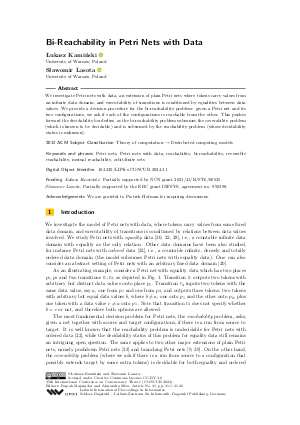LIPIcs.CONCUR.2024.31.pdf
- Filesize: 0.8 MB
- 20 pages

 Creative Commons Attribution 4.0 International license
Creative Commons Attribution 4.0 International license

We investigate Petri nets with data, an extension of plain Petri nets where tokens carry values from an infinite data domain, and executability of transitions is conditioned by equalities between data values. We provide a decision procedure for the bi-reachability problem: given a Petri net and its two configurations, we ask if each of the configurations is reachable from the other. This pushes forward the decidability borderline, as the bi-reachability problem subsumes the coverability problem (which is known to be decidable) and is subsumed by the reachability problem (whose decidability status is unknown).






















Feedback for Dagstuhl Publishing